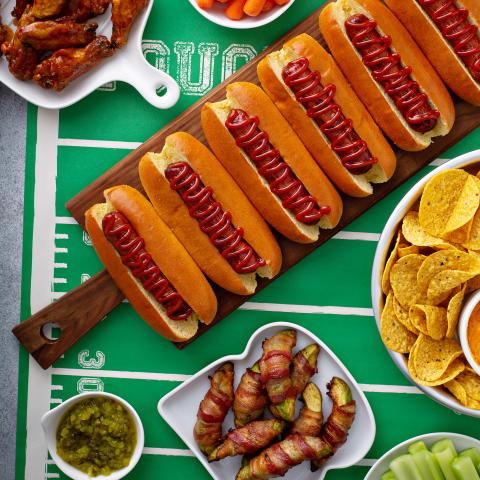
Game Day Gastronomy
by Alissa Dornink
Tailgating represents a uniquely North American socio-gastronomic phenomenon, transforming an unremarkable parking lot into a temporary culinary event. (Some say there is even a sporting event afterwards). These setups run from a couple of coolers and some folding chairs to fully operational kitchens in an outdoor environment, and if you are taking it that seriously you should check out some of the tailgate-specific cookbooks the library has. These cookbooks function not merely as sources of recipes, but as sacred documents that rigorously codify the culture of communal outdoor celebrating, teaching otherwise sane adults how to successfully haul their entire refrigerator (and smoker and grill and Blackstone) into a parking space.
Daina Falk does an excellent job highlighting the parameters of tailgate food, portability, durability, and deliciousness in “The Hungry Fan's Game Day Cookbook: 165 Recipes for Eating, Drinking & Watching Sports.” She goes beyond the basic limits of grilling, offering a strategic playbook designed to ensure your seven-layer dip doesn't tragically become a two-layer disaster on University Boulevard. Falk’s recipes focus on dishes that can be made ahead and are resilient enough to hold together during the ride there, recognizing that the food must also endure the trek across a parking lot packed in a cooler without sacrificing flavor. Her book is a manual for the ultimate game-day performance, ensuring food is the centerpiece of the fan experience.
While Falk focuses on the host's meticulous planning, you can’t forget the communal aspect of tailgating and the role of everyone attending. Tailgating is a collaborative event relying on everyone who shows up to provide something to share. Taste of Home’s “What Can I Bring?: 360+ Dishes for Parties, Picnics & Potlucks” provides the survival techniques to avoid being the person known for bringing potato salad with raisins. Casey Elsass’s “What Can I Bring?: Recipes to Help You Live Your Guest Life” provides a more nuanced view of the decision of what to contribute, framing the guest’s dish not just as food, but as an intentional gesture of social participation.
These three diverse culinary resources collectively document the evolution of tailgating into a serious, strategic gastronomic pursuit, confirming that the tradition is far more than brats before kickoff. It is a sophisticated, choreographed feast requiring planning and the willingness to accept that your entire life revolves around a folding table for four to six hours. Ultimately, the modern tailgater relies on these guides to successfully execute a communal experience built on gastronomy, fandom, and the shared realization that they brought more equipment than a professional catering crew.